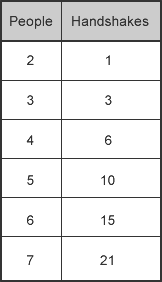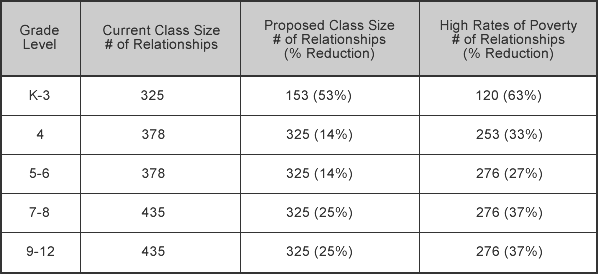Relationships are central to teaching, as we all know, and as class sizes creep up the ability of a teacher to have meaningful relationships with students diminishes greatly. Meaningful feedback, one of the most critical aspects of a teacher’s work, is a function of the time available divided by the number of students. Hope made a great point in her post last week that student-teacher ratios are one of the key measures of great colleges and private schools. In thinking about the student-teacher ratio, I am reminded of an interesting math problem known as the “handshake problem.” It’s about relationships – not just student-teacher relationships, but student-student relationships. All of these interactions impact the dynamic of the class.
The handshake problem is a great problem for early algebra students because it is easily understandable, slightly mind-boggling, and it is readily solved with algebra. It goes like this: Given a room with a particular number of people, how many handshakes will take place if each person shakes hands with everyone once?
We know that Person A needs to shake hands with Person B and that this will mean that B has already shaken hands with A and thus does not need to repeat this particular handshake… uh oh.
As you can see from the table at left, the number of handshakes is growing very rapidly. In fact, the number of relationships is a quadratic function of the number of people. The shapes (image at top) are another way to represent the connections: the points are the number of people and the line segments between them are handshakes. The number of handshakes – or relationships – in a classroom of 25 students (and 1 teacher) is 325! In Hope’s class of 41, there are 861. Below is a table showing the reduction in complexity of a classroom environment based on the proposed class size limits. (1 teacher is added to each class of students)
If we look at the 5th grade class size reduction in schools with low rates of poverty (just two students) we might at first think that this isn’t especially significant. After all, it’s only a 7% student reduction. But in the relationship analysis, there is a 14% reduction in the number of relationships in the classroom. Looking at it from the perspective of reducing the number of relationships within a given classroom gives some quantitative measure of the affect this reduction will have on the class. Class size data is not as simple as a student-teacher ratio; rather, this is just the beginning of an in-depth analysis. Classrooms are complex learning environments – each student adds an entirely unique ingredient to the mix.
It is important that all classes are not reduced equally. The relationships in grades K-3 are reduced by over 50% in all schools, and by 63% in schools with high rates of poverty. There is a great deal of research available that attests to the long-term benefits of early childhood intervention both from the student’s perspective and that of society. The continued emphasis on closing the achievement gap (sometimes called the opportunity gap) is a vital aspect of this initiative. By reducing class sizes the most in early grades and in schools where poverty is the greatest, opportunities can be provided where opportunities and resources have been scarce. (For more information see http://gradelevelreading.net/)
Finally, it is important to realize that this initiative is not just about class size. There are also increases to student support services “including librarians, counselors, school nurses, teaching assistants, and other critical staff necessary for the safe and effective operation of a school, to meet individual student needs, and to ensure all required school functions can be performed by appropriately trained personnel.” These roles too, are about relationships and the ability of school employees to meet student needs (Full text of Initiative 1351: http://sos.wa.gov/_assets/elections/initiatives/FinalText_578.pdf).



Pingback: A Response to Spencer’s “Handshake Post” | Stories From School
This is definitely a new way of thinking about the impact of class size! We often don’t consider the student-to-student interactions that come along with larger/smaller class sizes. Considering how socially tumultuous school can be, fewer and more manageable relationships might just enable some of my students to focus a little less on interpersonal drama and more on what we’re doing in class (kidding….sort of).